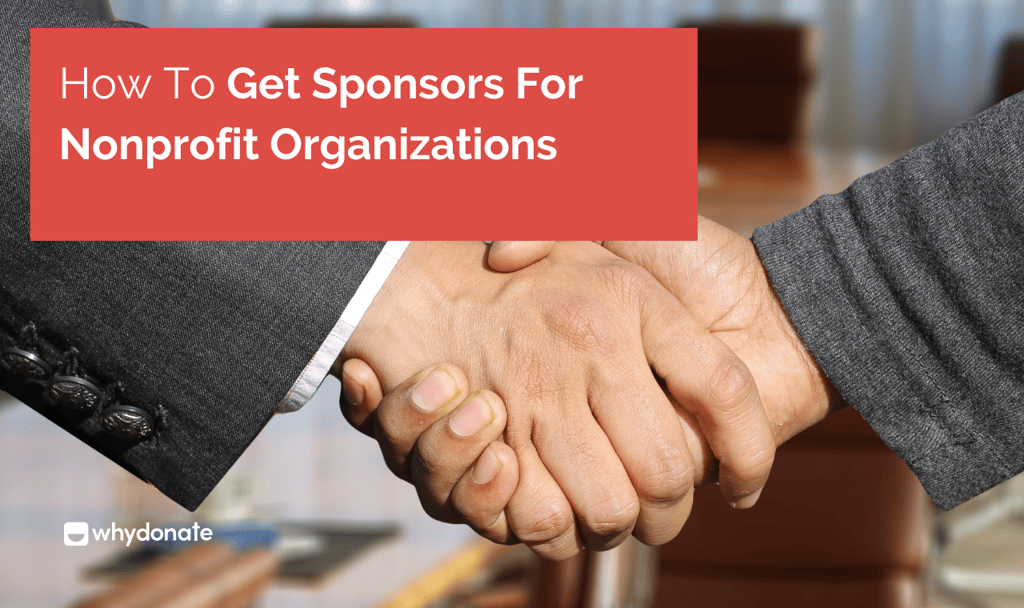For non-profit organizations, delvingon how to find sponsors and deciding on a funding model for their organization can be one of the most challenging tasks one has to do. Every organization needs money to stay afloat, and non-profit organizations there are, of course, no exception. Money is a common topic of conversation among non-profit professionals, and discussions about finding sponsors have become even more heated during economically unstable times.
Sponsors love seeing community support. Create a WhyDonate campaign and show them your project has real backing.
Table of Contents
How To Get Sponsorships & Donors?
On one hand, there are multiple financing models to choose from, which can cause confusion. On the other hand, some non-profits may feel less “flexible” and limited in their options. To make matters even more challenging, many professional non-profit organizations are hesitant to focus their efforts on raising funds and finding sponsors, reinforcing the misconception that seeking money is somehow “bad.”
Because this is a complicated topic, to help you through this, we’ve put together a list of the top eight non-profit funding sources you might want to consider—and tips on how to find sponsors for each model.
How To Acquire Sponsors For Nonprofit Organizations
Top Charity Sponsorship Ideas For Nonprofits
1. Individual donations
Of all donations to non-profit organizations, 71% come from individuals.
Individual donors are great options when it comes to getting sponsorship for non-profit organizations, as they can make one-time or recurring donations. They also give in various ways: online and offline, through events, auctions, scheduled donations, and more.
When it comes to individual donations, it is essential to consider all your options because they are such a massive part of a non-profit’s funding. For the most part, this is a very effective source of funding, especially for those organizations with large marketing budgets and who have a target of high appeal (e.g., cancer).
💡 Tip: Start by creating a compelling campaign page that shows real impact. This builds trust and helps you acquire individual sponsors.
Major donors
Large donors often give less, but their donations are considerably larger. Make sure your fundraising model nurtures key donors. What is considered a “large donation” depends on the organization. Look at your overview of donations and select the largest donation(s) you have received in the past. For a large and established organization, this could be a six-figure donation, while for smaller non-profits, it could be several thousand dollars. Recruiting and maintaining large donors is a little different from maintaining regular donors.
To attract large donors, consider investing in philanthropy screening software. If possible, consider appointing a team member to work with key donor leads. To secure a large donation, you usually have to attend many meetings, invite the potential donor to your office, arrange a meeting with the board, and often send relevant updates.
Regular donors
Regular donors tend to give more often, but their donations are smaller in size. To maintain regular donors, you can use a variety of donor acquisition and retention techniques. Many non-profit professionals recommend that you convert regular donors into recurring donors. This provides your non-profit with a sustainable income and allows you to plan your activities.

2. Crowdfunding
Crowdfunding works best for specific campaigns and when you’re telling specific stories. It is critical to invest time and effort in making your online donation page shine. Make sure that the potential donors encounter a user-friendly website and have a smooth crowdfunding experience. Your donate button should be easy to find, and the donation link should be accessible within seconds of your donation page loading. Design your donation page to match the rest of the website.
It is also crucial to design a donation page that is mobile-friendly/responsive. Keep the donation page on one page. Keep it simple and straightforward, with a call to action at the front and center. Use powerful images and offer multiple payment options. Crowdfunding has become popular through the proliferation of various online platforms such as Whydonate and is used by corporates as well as non-profits.
There are many different types of crowdfunding (reward-based crowdfunding, human capital crowdfunding, equity crowdfunding, etc.), but donation-based crowdfunding is the most commonly used by non-profits. To get the most out of donation-based crowdfunding, you need to post regular updates, use compelling images and videos, offer incentives, and share via email and social media. Make sure you tell a story – a story is what fuels a crowdfunding campaign.
-
Peer-to-peer Fundraising
Peer-to-peer fundraising and getting sponsorship for non-profit organizations is a subcategory of crowdfunding. Instead of having one crowdfunding page where everyone donates, individual fundraisers in peer-to-peer fundraising usually set up a personal fundraising page to accept donations, which are then received by your non-profit.
This strategy leverages your donors’ existing networks. It encourages supporters to reach out to their peers, friends, colleagues, and family members for donations and find sponsors.
Peer-to-peer fundraising is effective because it builds on relationships, leverages your pre-existing donor base, and contributes to providing social proof. We are more likely to trust a publication if it is created by a friend or family member. Peer-to-peer fundraising and getting charity sponsorship for non-profit organizations also work well because it’s exponential. All of your supporters’ individual campaigns are surging out and bringing you more donors.
Create your WhyDonate campaign link to share with potential sponsors right away.
3. Offline Fundraising
-
Letters / Direct Mail
This offline fundraising method is still widely used by non-profit organizations because it is generally inexpensive, effective, and easy to find sponsors. It’s beneficial for smaller non-profits or non-profits that work locally. In addition, older donors prefer direct mail (fundraising letters). If your non-profit has a pool of older donors, direct mail is very effective.
-
Events
Events have been effective tools for fundraising and getting sponsorship for non-profit organizations for many years because they provide a space for the non-profit and potential donors to interact. Events can also boost your online fundraising. Donors are more likely to give if they can name faces.
-
Door-to-door
Although door-to-door fundraising has declined over the years due to its labor-intensive nature, many organizations still use it when it comes to getting sponsorship for non-profit organizations.
-
Phone Requests
Phone requests are donation requests made over the phone and can range from an employee making a few “thank you” calls to major telemarketing campaigns. As with door-to-door fundraising, this technique has declined over the years as online fundraising grows, but it can still be effective for some non-profits to find sponsors.

4. Government/Private Subsidies
Non-profit organizations can apply for grants from the government and private and public foundations at the municipal and state levels. In general, you do not have to pay back money that has been awarded to you through a grant. Globally, In almost every country, your organization must have charitable/non-profit status to receive a grant.
Each grant organization has different requirements and may also depend on the country in which your non-profit is registered. One of the benefits of a grant is that it can support significant projects, enabling them to have a large-scale social impact that would otherwise not be possible. The downside is that it can take a significant amount of time. First, it takes time to develop the skills for writing a grant application, which actually leads to the payment of a grant, and then it can take a while to see the funds.
In addition, subsidies are often linked to specific conditions. These conditions apply to matters such as how exactly you can use the money. They also have specific reporting requirements, which you should consider before applying. The conditions can also be related to certain outputs or outcomes or the achievement of agreed milestones. Grants can be very attractive to non-profits, but you should think carefully before applying for them. Here are a few things to consider before deciding to use grants as part of your fundraising/funding model.
💡 Many successful organizations treat grantmakers as sponsors—cultivating relationships, showing impact, and following up regularly.
Considerations
- Can we invest resources in writing rewarding grant applications?
- Can we meet the subsidy conditions?
- Are the activities we would perform in line with our mission, goals, and strategy?
- Can the activity be continued after the subsidy has ended?
For some organizations, grants are the ideal source of funding, while others find them too cumbersome and restrictive. That’s why it’s important to answer the questions above first to ensure that a grant is best for your non-profit right now.
If you live in the Netherlands, there is a searchable online database of funds to help you find what you are looking for.

5. How To Get Corporate Sponsorships For Nonprofits
Finding sponsors and corporate sponsorships can be an excellent source of funding for non-profits. Companies are often willing to collaborate on projects to improve their CSR image or contribute to a cause they care about.
Here’s how to find sponsors through corporate partnerships:
- Research companies that align with your mission.
- Reach out with a professional proposal that outlines mutual benefits.
- Offer visibility through your events, website, and social media.
- Be clear about your audience and impact. Companies want data!
Corporate sponsorships usually come in three major forms:
- Philanthropic – no strings attached donations, similar to individual donations
- Event sponsorship – episodic or short-term support, finding sponsors based on an event
- Cause-Based Marketing – Longer-term thematic engagement and locating sponsors by engagement
There are also donation matching programs – where companies match the donations of their employees. When considering corporate sponsorship as one of the funding sources for your non-profit, don’t forget to consider overhead. Someone has to manage the partnerships, especially if you plan to make business partnerships and finding sponsors is one of your primary sources of income.
🔍 Bonus: Explore donation matching programs as another way to acquire corporate sponsors.

6. Membership Fee & Alumni Contributions
This non-profit funding source doesn’t always work for every non-profit, but it is worth looking into. Consider your non-profit’s mission, then decide if you want to use the revenue stream for membership fees. This funding source is particularly effective if your non-profit can offer exclusive programs and/or perks and benefits to its members.
A subcategory of the membership model is funding through former beneficiaries or alumni. This model works exceptionally well for hospitals and universities, which generate a sense of “return” in their former beneficiaries and thus find sponsors. This particular funding source from past “beneficiaries” works if your organization serves a large, high-turnover community. In this regard, Princeton University is an excellent example of the way it finds sponsors.
The university is very adept at approaching alumni for donations, and they have the highest number of alumni of any national university, donating at 59.2%. In 2008, more than 33,000 undergraduate alumni donated $43.6 million to their alma mater. As a result of the university’s fundraising efforts, more than 50% of Princeton’s operating budget is paid for through donations and endowment income.
This works because previous beneficiaries feel that they have received many benefits from the institution in the past and are eager to provide others with the same benefits. Past beneficiaries see the individual benefit they have received in the past as a higher social good. Before you start finding sponsors and decide to use membership fees in one form or another as a source of funding, ask yourself the following questions.
How to acquire sponsors through alumni and former beneficiaries?
- Build an alumni database.
- Share impact stories regularly.
- Invite past beneficiaries to sponsor current initiatives.
Considerations
- Do we have programs that have loyal supporters and people who want to spread the word?
- Can we invest in long-term relationships with our beneficiaries?
- Do we have the capacity to reach the beneficiaries after they use our services?
- Do we offer exclusive perks and benefits to justify a membership fee?
7. Selling Products And Services
Another source of funding your non-profit may consider is selling products and/or services. For example, you can sell items with your brand/logo to generate income for your organization. This usually concerns t-shirts, bags, cups, cookies, and other products. Goodwill Industries, for example, is probably the largest non-profit retailer. Many non-profit organizations also charge for some of their services.
For example, hospitals bill patients, museums charge entrance fees, theatres sell tickets, community organisations charge dues, colleges require tuition, and so on. This can be a great source of income for your non-profit, but as always, this funding source doesn’t always apply to every non-profit. According to the National Center for Charitable Statistics, in 2013, such sources of income provided nearly half (47.5%) of total revenue for public charities. And a quarter of the revenue came from government contracts for services.
Selling products and services is sometimes referred to as “trade” or “earned income.” Here are more examples of selling products and services:
- Sell event tickets.
- Create and sell publications.
- The sale of internal expertise, e.g., writing, training, and consultations.
Non-profits can sell in most countries. If the sale of products and services is a significant part of your budget, you should seek expert advice. If these activities are not related to your primary purpose, charities will have tax and tax implications. Be careful with your earned income and track the percentage of income that consists of products and services for your organization.
Example: A local business might sponsor your next run of tote bags or t-shirts in exchange for their logo being featured.
8. In-Kind Donations
Sponsorship for nonprofits is a very important subject. So, nonprofits should always be open to in-kind donations. In-kind donations are not helpful to every non-profit but can be an invaluable source of support for non-profits such as animal shelters, homeless shelters, anonymous shelters, or humanitarian aid organizations. Examples of in-kind donations are food, clothing, and medicines. If finding sponsors for in-kind contributions works for your organizational model, they can save you a lot of money. For example, if your organization wants to bring food and water to areas affected by natural disasters, it is very helpful to be supplied in kind.
You may not be able to use the in-kind donations directly for your programs. In that case, you can always use them for auctions (depending on the type of products). If you choose to do this, you should clearly communicate (ideally on your website) which items you can accept and where your collection points – if not in the office – are. It is important to note that in-kind donations do not only include items such as food, clothing, and medicines.
When asking how to get sponsorships, remember to think outside the box:
- A developer can build your website.
- A local bakery can donate catering for your fundraiser.
- A yoga instructor can offer free classes in exchange for exposure.
🎯 Tip: Make a wishlist and share it on your site or campaign page to attract the right sponsors.
Start Finding Sponsors
While opinions vary about what constitutes the “ideal” funding model for a non-profit on the journey of how to get sponsors for a fundraiser, using different sources to achieve sustainability is generally good practice. In general, it is recommended that non-profits never receive more than 30% of their funding from a single source. If an organization loses 30% of its revenue, it can probably be restructured to survive.
It is important to keep in mind that we’ve outlined here possible sources of funding, but certainly not all the necessary financial models for running a non-profit. When it comes to securing funds for your organization, make sure you have a plan. Whether it is individuals, foundations, corporations, or government funding, invest in relationships with donors and find sponsors. All these relationships take time to develop and must be maintained. You must respect any kind of support.
It takes creativity, commitment, and hard work to solve income challenges. Each funding source has opportunities and challenges, and each, of course, has its advantages and disadvantages. Regardless of which one you choose, they all require effort, focus, and investment to find sponsors.
For more tips for non-profit organizations and how to get sponsors for a fundraiser, visit our non-profit blog.
Take the next step — start your fundraising campaign on WhyDonate and attract sponsors with real momentum behind your cause.

















